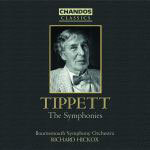
Tippett: Symphonies / New Year Suite
 $80.00
Out of Stock
$80.00
Out of Stock6+ weeks add to cart
MICHAEL TIPPETT
Tippett: Symphonies / New Year Suite
Faye Robinson, soprano / Bournemouth Symphony Orchestra / Richard Hickox, conductor
[ Chandos Classics / 3 CD ]
Release Date: Tuesday 18 October 2005
This item is currently out of stock. It may take 6 or more weeks to obtain from when you place your order as this is a specialist product.
'This is keen-eyed, thoroughly committed playing. What cannot be overstated is the mastery of Hickox's imaginative reading… Chandos's sound throughout possesses exciting realism.'
- Hi-Fi News
'Hickox's Tippett cycle goes from strength to strength.'
- BBC Music
'Hickox's Tippett cycle is becoming one of the musical events of the decade.'
- Classic CD
'This is Tippett firing on all cylinders, with a performance and recording to match.'
- Gramophone
To celebrate the centenary of the birth of Sir Michael Tippett, Chandos is releasing Richard Hickox's highly acclaimed recordings of his symphonies and the Suite from the opera New Year, packaged in a handsome cat-box - and at a special price: 3 discs for the price of 2.
These recordings received unanimous critical acclaim, both as performances and sound, on their original release, and remain central in the Tippett discography.
A fundamental aspect of the work of Sir Michael Tippett, especially of the symphonies, was his attempt to recreate, in his own twentieth-century terms, the dynamism, energy, and humanistic dimension of Beethoven's art. In the third movement of the First Symphony (1944-45) he set himself the task of generating the momentum of the Beethovenian scherzo, and the finale of the same work is a majestic double fugue that recalls the last movement of the 'Hammerklavier' Piano Sonata. The first movement of the Second Symphony (1956-57) is modelled on the Beethovenian sonata-form process, while Tippett's recourse to words, and these words themselves, in the finale of the bold Third Symphony (1970-72) overtly relate to Beethoven's Ninth, a kinship further emphasised by the quotation of the renowned opening of the Ninth's finale. Tippett was also an admirer and champion of the music of Purcell, and his technique of developing material by means of contrast recalls Purcell's string fantasias whose form is generated by a sequence of musical ideas. This concept is present in the opening pages of the First and Third Symphonies, in the form of the Second Symphony's finale, and in the division of the single span of the Fourth Symphony (1976-77) into seven sections. Tippett's penchant for the use of variations on a ground bass, as in the slow movement of the First Symphony and the finale of the Second, is a further product of Purcellian influence.
Tippett's fifth opera, New Year, received its first US and British performances in Houston and Glyndebourne in 1989 and 1990 respectively. The Suite from 'New Year' draws on music from the opera, but was conceived by Tippett as an independent concert work in the manner, he suggests, of Berg's Three Fragments from 'Wozzeck'. The suite was commissioned by the San Francisco Symphony Orchestra and given its premiere in 1990, conducted by Muhai Tang. In thirteen episodes that play continuously but do not follow the sequence of the opera's action, the suite is full of memorable musical invention.